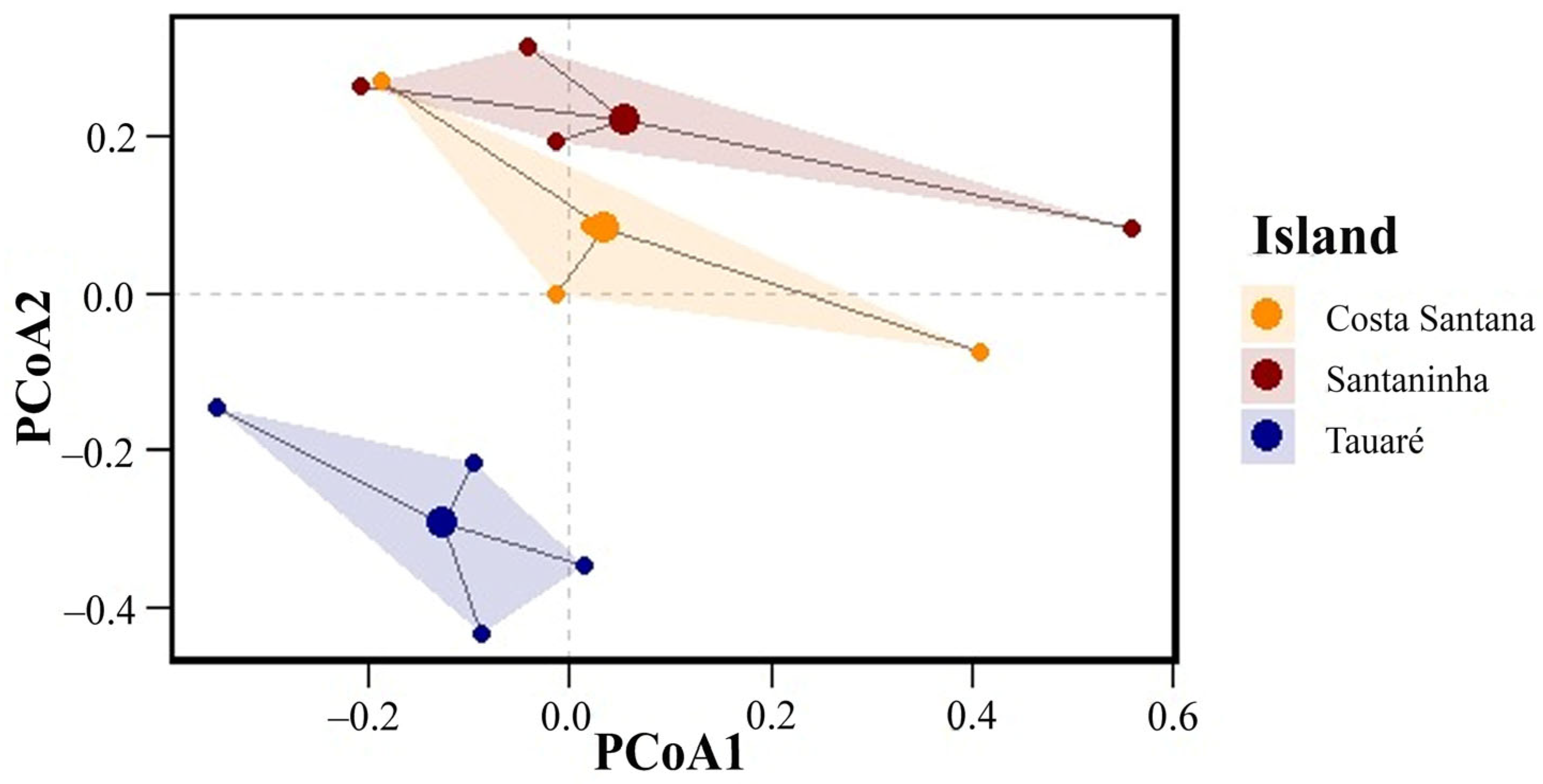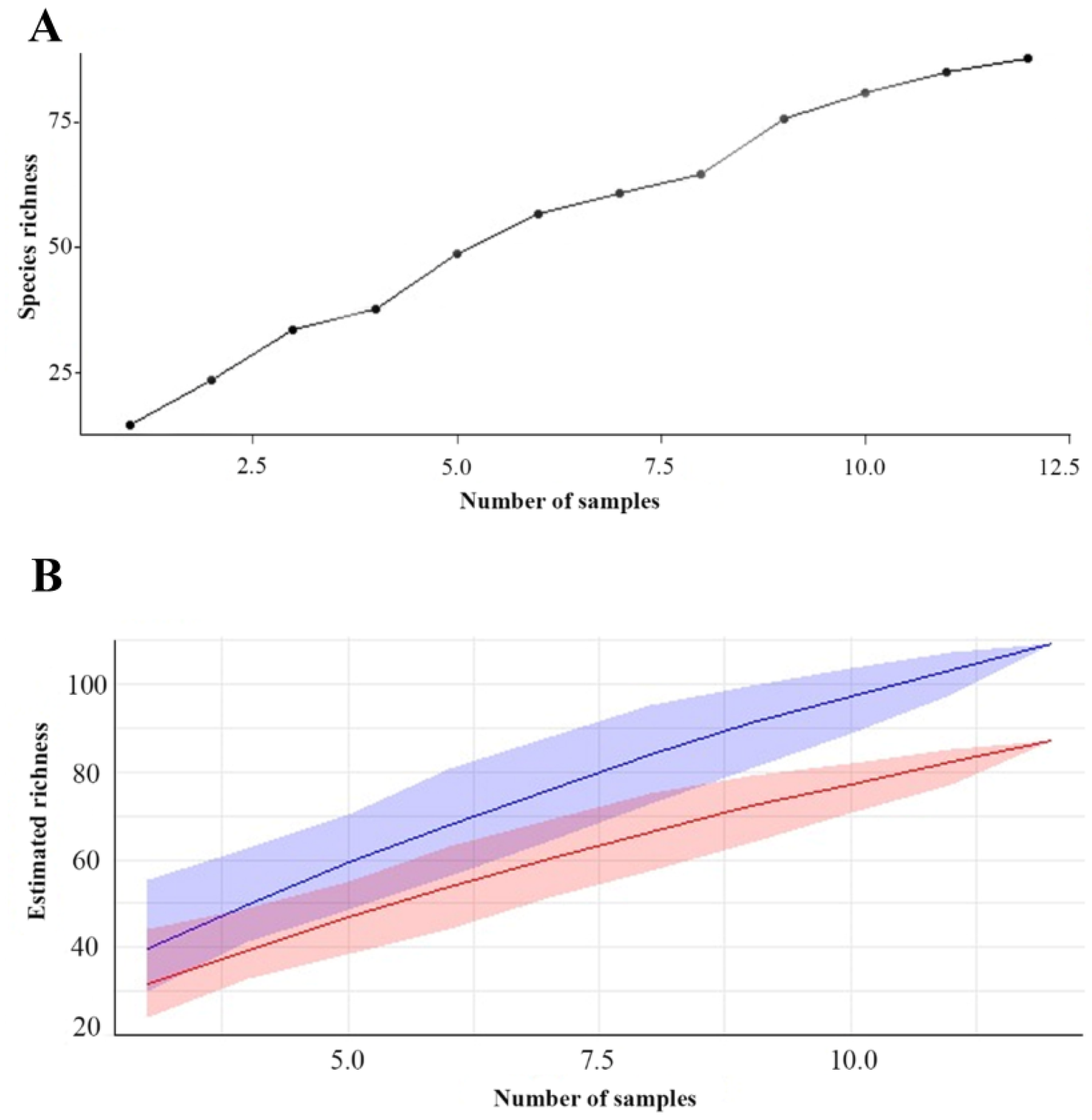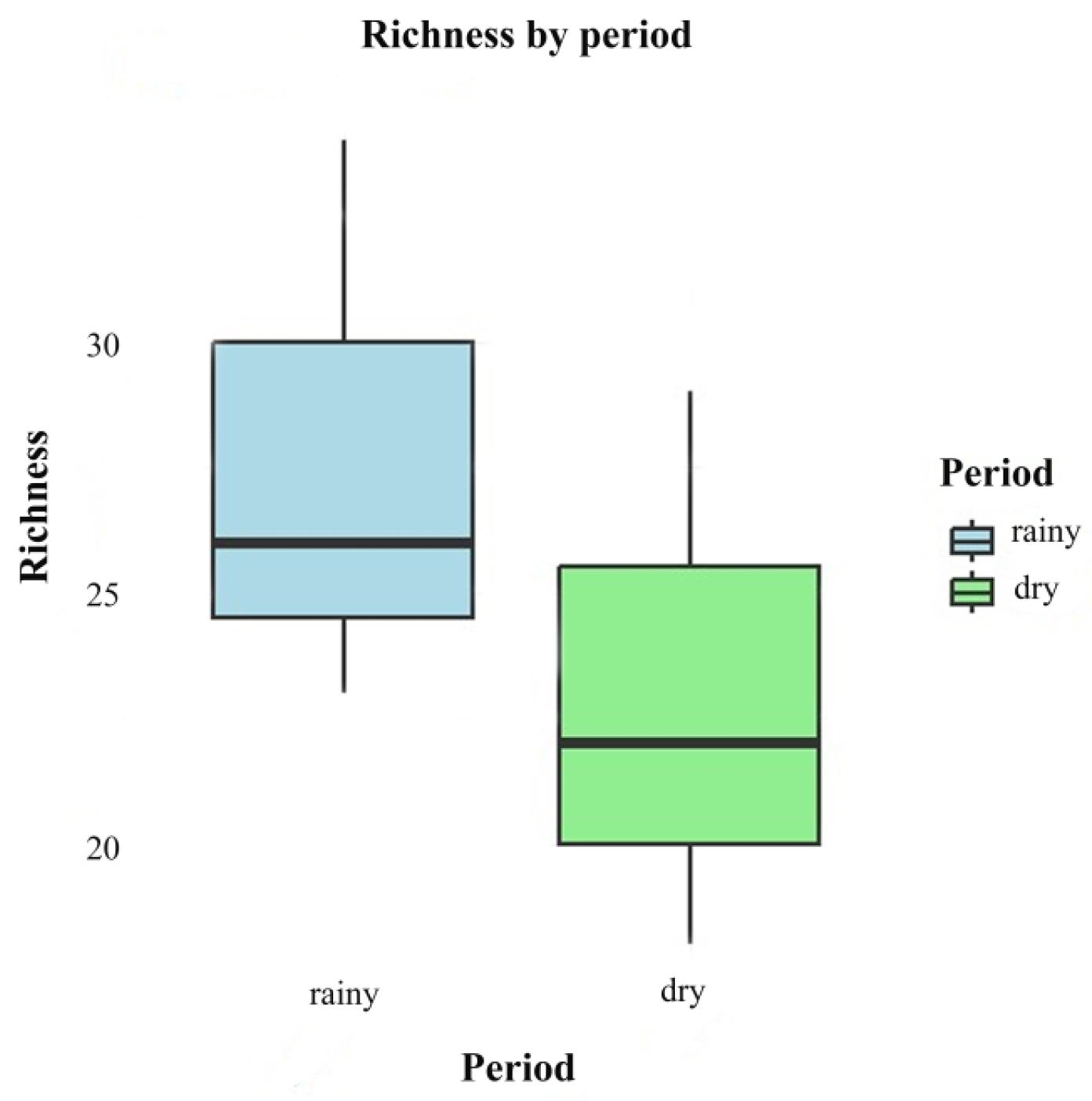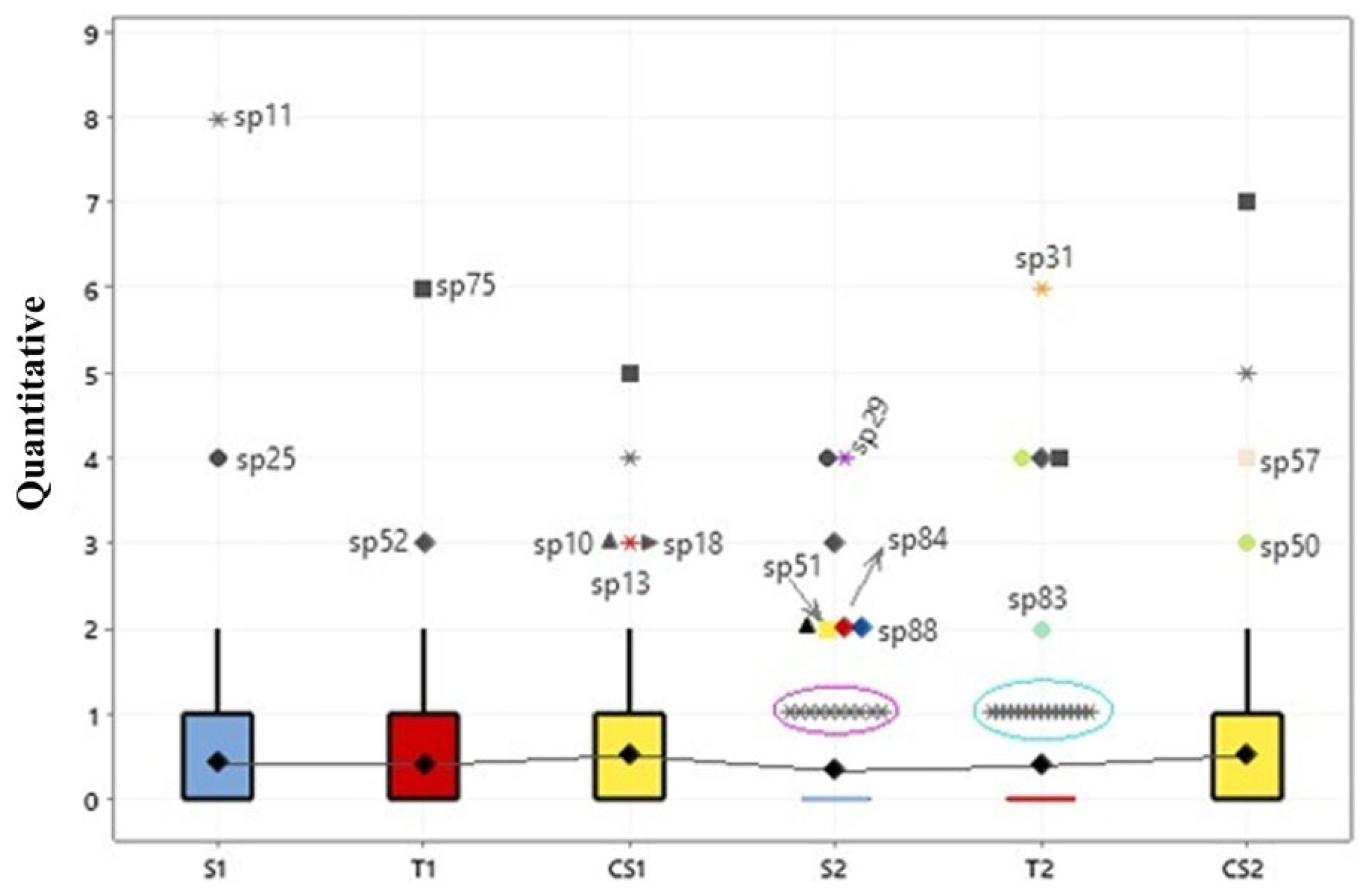Distribution Patterns of Wood-Decay Macrofungi (Agaricomycetes) in Floodplain Forest Islands of the Eastern Amazon
Abstract
1. Introduction
2. Materials and Methods
2.1. Study Area
2.2. Collection, Processing, and Identification
2.3. Statistical Analysis
3. Results
3.1. Macrofungal Diversity, Richness and Composition Among the Islands
3.2. Seasonal Diversity on the Three Islands
4. Discussion
4.1. Composition and Richness Among the Islands
4.2. Seasonal Diversity
4.3. Future Research Directions
5. Conclusions
Author Contributions
Funding
Institutional Review Board Statement
Informed Consent Statement
Data Availability Statement
Acknowledgments
Conflicts of Interest
References
- Zappi, D.C. Tipos de Vegetação da Amazônia com ênfase no Pará. In Abelhas Sem Ferrão do Pará: A Partir das Expedições Científicas de João M. F. Camargo; Imperatriz-Fonseca, V.L., Alves, D.A., Eds.; Instituto Tecnolégico Vale: Belém, Brazil, 2020; pp. 17–31. [Google Scholar]
- Prance, G.T. Notes on the Vegetation of Amazonia III. The Terminology of Amazonian Forest Types Subject to Inundation. Brittonia 1979, 31, 26. [Google Scholar] [CrossRef]
- Maués, B.A.R.; Jardim, M.A.G.; Batista, F.d.J.; Medeiros, T.D.S.; Quaresma, A.C. Composição florística e estrutura do estrato inferior da Floresta de Várzea na Área de Proteção Ambiental Ilha do Combu, município de Belém, Estado do Pará. Rev. Árvore 2011, 35, 669–677. [Google Scholar] [CrossRef]
- Wittmann, F.; Householder, J.E.; Piedade, M.T.F.; Schöngart, J.; Demarchi, L.O.; Quaresma, A.C.; Junk, W.J. A Review of the Ecological and Biogeographic Differences of Amazonian Floodplain Forests. Water 2022, 14, 3360. [Google Scholar] [CrossRef]
- Householder, J.E.; Wittmann, F.; Schöngart, J.; Piedade, M.T.F.; Junk, W.J.; Latrubesse, E.M.; Quaresma, A.C.; Demarchi, L.O.; de S. Lobo, G.; Aguiar, D.P.P.; et al. Author Correction: One Sixth of Amazonian Tree Diversity Is Dependent on River Floodplains. Nat. Ecol. Evol. 2024, 8, 1046–1047. [Google Scholar] [CrossRef] [PubMed]
- Guimarães, D.F.d.S.; Silva, S.C.P.; Vasconcelos, M.A.; Mendes, G.S.; Pereira, H.S. A Morte Catastrófica de Árvores Por Inundação Na Ilha Do Careiro Da Várzea-AM. Terceira Margem Amaz. 2019, 5, 13. [Google Scholar] [CrossRef]
- Ávila, J.V.C.; Ticktin, T.; Steward, A.M.; Giehl, E.L.H.; Cantor, M.; Clement, C.R. Recovery of Local Agrobiodiversity after an Extreme Flood in Amazon Floodplains. Biol. Conserv. 2024, 292, 110536. [Google Scholar] [CrossRef]
- Freitas, M.A.B.; Vieira, I.C.G.; Albernaz, A.L.K.M.; Magalhães, J.L.L.; Lees, A.C. Floristic Impoverishment of Amazonian Floodplain Forests Managed for Açaí Fruit Production. For. Ecol. Manag. 2015, 351, 20–27. [Google Scholar] [CrossRef]
- Junk, W.J.; Piedade, M.T.F. An Introduction to South American Wetland Forests: Distribution, Definitions and General Characterization. In Amazonian Floodplain Forests: Ecophysiology, Biodiversity and Sustainable Management; Springer: Berlin/Heidelberg, Germany, 2010; p. 210. [Google Scholar]
- Choueri, R.B.; Azevedo, J.A.R. Biodiversidade e Impacto de Grandes Empreendimentos Hidrelétricos na Bacia Tocantins-Araguaia: Uma Análise Sistêmica. Soc. Nat. 2017, 29, 439–453. [Google Scholar] [CrossRef]
- Kowalska, N.; Šigut, L.; Stojanović, M.; Fischer, M.; Kyselova, I.; Pavelka, M. Analysis of Floodplain Forest Sensitivity to Drought. Philos. Trans. R. Soc. B Biol. Sci. 2020, 375, 20190518. [Google Scholar] [CrossRef]
- Niego, A.G.T.; Lambert, C.; Mortimer, P.; Thongklang, N.; Rapior, S.; Grosse, M.; Schrey, H.; Charria-Girón, E.; Walker, A.; Hyde, K.D.; et al. The Contribution of Fungi to the Global Economy. Fungal Divers. 2023, 121, 95–137. [Google Scholar] [CrossRef]
- Lisboa, D.O.; Evans, H.C.; Araújo, J.P.M.; Elias, S.G.; Barreto, R.W. Moniliophthora perniciosa, the Mushroom Causing Witches’ Broom Disease of Cacao: Insights into Its Taxonomy, Ecology and Host Range in Brazil. Fungal Biol. 2020, 124, 983–1003. [Google Scholar] [CrossRef] [PubMed]
- Li, Y.; Zhang, T.; Zhou, Y.; Zou, X.; Yin, Y.; Li, H.; Liu, L.; Zhang, S. Ectomycorrhizal Symbioses Increase Soil Calcium Availability and Water Use Efficiency of Quercus Acutissima Seedlings under Drought Stress. Eur. J. For. Res. 2021, 140, 1039–1048. [Google Scholar] [CrossRef]
- Chot, E.; Reddy, M.S. Role of Ectomycorrhizal Symbiosis Behind the Host Plants Ameliorated Tolerance Against Heavy Metal Stress. Front. Microbiol. 2022, 13, 855473. [Google Scholar] [CrossRef] [PubMed]
- Goodell, B.; Qian, Y.; Jellison, J. Fungal Decay of Wood: Soft Rot-Brown Rot-White Rot. In ACS Symposium Series; Schultz, T.P., Militz, H., Freeman, M.H., Goodell, B., Nicholas, D.D., Eds.; ACS Publications: Aurora, IL, USA, 2008; Volume 982, pp. 9–31. ISBN 9780841239517. [Google Scholar]
- Mazumder, M.; Roy, S.; Sarkar, A.K. Pharmacological and Therapeutic Value of Bamboo Mushroom Phallus Indusiatus (Agaricomycetes). Ital. J. Mycol. 2022, 51, 47–57. [Google Scholar]
- Cattanio, J.H.; Anderson, A.B.; Carvalho, M.S. Floristic Composition and Topographic Variation in a Tidal Floodplain Forest in the Amazon Estuary. Rev. Bras. Botânica 2002, 25, 419–430. [Google Scholar] [CrossRef]
- Almeida, S.S.; Amaral, D.D.; Silva, A.S.L. da Análise Florística e Estrutura de Florestas de Várzea No Estuário Amazônico. Acta Amaz. 2004, 34, 513–524. [Google Scholar] [CrossRef]
- Assis, R.L.; Wittmann, F. Forest Structure and Tree Species Composition of the Understory of Two Central Amazonian Várzea Forests of Contrasting Flood Heights. Flora-Morphol. Distrib. Funct. Ecol. Plants 2011, 206, 251–260. [Google Scholar] [CrossRef]
- Assis, R.L.; Wittmann, F.; Piedade, M.T.F.; Haugaasen, T. Effects of Hydroperiod and Substrate Properties on Tree Alpha Diversity and Composition in Amazonian Floodplain Forests. Plant Ecol. 2015, 216, 41–54. [Google Scholar] [CrossRef]
- Assis, R.L.; Wittmann, F.; Bredin, Y.K.; Schöngart, J.; Nobre Quesada, C.A.; Piedade, M.T.F.; Haugaasen, T. Above-Ground Woody Biomass Distribution in Amazonian Floodplain Forests: Effects of Hydroperiod and Substrate Properties. For. Ecol. Manag. 2019, 432, 365–375. [Google Scholar] [CrossRef]
- Zocatelli, R.; Moreira-Turcq, P.; Bernardes, M.; Turcq, B.; Cordeiro, R.C.; Gogo, S.; Disnar, J.R.; Boussafir, M. Sedimentary Evidence of Soil Organic Matter Input to the Curuai Amazonian Floodplain. Org. Geochem. 2013, 63, 40–47. [Google Scholar] [CrossRef]
- Nogueira, K.N.S.; Costa, F.D.A.; Adami, M. Território e Trabalho: Análise Geoeconômica com base em Trajetórias Camponesas. Novos Cad. NAEA 2018, 21, 1. [Google Scholar] [CrossRef][Green Version]
- Barros, D.J.; Carvalho, G.A.; Chaves, M.G.; Vanzela, L.S.; Kozusny-Andreani, D.I.; Guarda, E.A.; Neu, V.; Morais, P.B.; Tsai, S.M.; Navarrete, A.A. Microbial Metabolic Activity in Amazon Floodplain Forest and Agricultural Soils. Front. Microbiol. 2023, 14, 1144062. [Google Scholar] [CrossRef] [PubMed]
- INMET—Instituto Nacional de Metereologia. Gráficos Climátológicos; Ministério Da Agricultura e Pecuária: Brasília, DF. Available online: www.inmet.gov.br (accessed on 20 December 2024).
- Fidalgo, O.; Bononi, V.L.R. Técnicas de Coleta, Preservação e Herborização de Material Botânico; Instituto de Botânica: São Paulo, Brazil, 1989; p. 62. [Google Scholar]
- Neves, M.A.; Baseia, I.G.; Drechsler-Santos, E.R.; Góes-Neto, A. Guide to the Common Fungi of the Semiarid Region of Brazil; TECC Editora: Florianópolis, Brazil, 2013. [Google Scholar]
- Teixeira, A.R. Métodos Para Estudos Das Hifas Do Basidiocarpo de Fungos Poliporáceos; Instituto de Botânica: São Paulo, Brazil, 1995. [Google Scholar]
- Ryvarden, L. A Note on the Genus Hydnodon Banker. Synopsis Fungorum 2002, 15, 31–33. [Google Scholar]
- Ryvarden, L. Neotropical Polypores. Part 1. Introduction Ganodermataceae & Hymenochaetaceae. Synop. Fungorum 2004, 19, 238. [Google Scholar]
- Ryvarden, L. The Genus Inonotus—A Synopsis; Fungiflora: Oslo, Norway, 2005. [Google Scholar]
- Ryvarden, L. Studies in Neotropical Polypores 37. Some New and Interesting Species from Tropical America. Synopsis Fungorum 2014, 32, 58–67. [Google Scholar]
- Ryvarden, L. Neotropical Polypores. Part 3, Polyporaceae, Obba-Wrightoporia; Fungiflora: Oslo, Norway, 2016; Volume 46. [Google Scholar]
- Zabin, D.A.; Spirin, V.; Vlasák, J.; Coelho-Nascimento, C.; Menolli, N. Taxonomic Reinvestigation of Favolus in the Neotropics Utilizing Morphological and Multigene Phylogenetic Analyses. Mycol. Prog. 2024, 23, 44. [Google Scholar] [CrossRef]
- Gomes-Silva, A.C.; Medeiros, P.S.; Soares, A.M.S.; Sotão, H.M.P.; Ryvarden, L.; Gobertoni, T.B. Two New Species of Rigidoporus (Agaricomycetes) from Brazil and New Records from the Brazilian Amazonia. Phytotaxa 2014, 156, 191–200. [Google Scholar] [CrossRef]
- Nolan, K.A.; Callahan, J.E. Beachcomber Biology: The Shannon-Weiner Species Diversity Index. In Tested Studies for Laboratory Teaching: Proceedings of the 27th Workshop/Conference of the Association for Biology Laboratory Education (ABLE); Association for Biology Laboratory Education: Claremont, CA, Canada, 2006; pp. 334–338. [Google Scholar]
- Lindblad, I. Host Specificity of Some Wood-Inhabiting Fungi in a Tropical Forest. Mycologia 2000, 92, 399–405. [Google Scholar] [CrossRef]
- Wang, W.; Sun, J.; Zhong, Z.; Xiao, L.; Wang, Y.; Wang, H. Relating Macrofungal Diversity and Forest Characteristics in Boreal Forests in China: Conservation Effects, Inter-forest-type Variations, and Association Decoupling. Ecol. Evol. 2021, 11, 13268–13282. [Google Scholar] [CrossRef]
- R Core Team. R: A Language and Environment for Statistical Computing; R Foundation for Statistical Computing: Vienna, Austria. Available online: https://www.r-project.org/ (accessed on 10 June 2023).
- Botelho, E.V.D. Avaliação Da Fertilidade de Solos de Cacau de Várzeas, Mocajuba–PA. In Proceedings of the 62nd Congresso Brasileiro de Química; UFRN: Natal, Brazil, 2023; pp. 1–18. [Google Scholar]
- Yu, Y.; Liu, H.; Zhang, L.; Sun, Z.; Lei, B.; Miao, Y.; Chu, H.; Han, S.; Shi, Y.; Zheng, J. Distinct Response Patterns of Plants and Soil Microorganisms to Agronomic Practices and Seasonal Variation in a Floodplain Ecosystem. Front. Microbiol. 2023, 14, 1094750. [Google Scholar] [CrossRef]
- Gibertoni, T.B.; Ryvarden, L.; Bernicchia, A.; Savino, E. Poroid Fungi (Agaricomycetes, Basidiomycota) in the National Caxiuanã Forest. In Caxiuanã, Paraíso Ainda Preservado; Lisboa, P.L.B., Ed.; Museu Paraense Emílio Goeldi: Pará, Brazil, 2013; pp. 397–409. [Google Scholar]
- Sotão, H.M.P.; Medeiros, P.S.; Gibertoni, T.B. Fungos Macroscópicos Da Floresta Nacional de Caxiuanã, Pará, Brasil: Basidiomycota (Agaricomycetes). In Caxiuanã: Desafios para Conservação de uma Floresta Nacional na Amazônia; Lisboa, P.L.B., Ed.; Museu Paraense Emílio Goeldi: Pará, Brazil, 2009; pp. 383–396. [Google Scholar]
- Soares, A.M.S.; Medeiros, P.S.; Gibertoni, T.B. Riqueza de Fungos Poliporoides (Agaricomycetes, Basidiomycota) Em Uma Floresta Ombrófila Densa No Amapá, Amazônia Brasileira. Bol. Mus. Biol. Mello Leitão 2014, 35, 5–18. [Google Scholar]
- Xavier, W.K.S.; Sotão, H.M.P.; Soares, A.M.D.S.; Gibertoni, T.B.; Rodrigues, F.D.J.; Ryvarden, L. Riqueza de Agaricomycetes Poroides Da Serra Do Navio, Amazônia Oriental, Com Novo Registro de Oxyporus Lacera Para o Brasil. Bol. do Mus. Para. Emílio Goeldi-Ciências Nat. 2018, 13, 303–315. [Google Scholar] [CrossRef]
- Couceiro, D.d.M.; Soares, A.M.S.; Couceiro, S.R.M. Contribution to the Knowledge of Polypores (Agaricomycetes) in the Amazonian Forest, with 16 New Records for the State of Pará, Brazil. Res. Soc. Dev. 2022, 11, e35111436024. [Google Scholar] [CrossRef]
- Lopez-Quintero, C.A.; Straatsma, G.; Franco-Molano, A.E.; Boekhout, T. Macrofungal Diversity in Colombian Amazon Forests Varies with Regions and Regimes of Disturbance. Res. Soc. Dev. 2012, 21, 2221–2243. [Google Scholar] [CrossRef]
- De Castro, C.C.; Gutiérrez, A.H.; Sotão, H.M.P. Fungos Conidiais em Euterpe Oleracea Mart. (Açaizeiro) Na Ilha Do Combu, Pará-Brasil. Acta Bot. Brasilica 2012, 26, 761–771. [Google Scholar] [CrossRef]
- Putra, P.S.; Supriadi; Achmad, A.; Yamada, T.; Ngakan, P.O. Seasonal Diversity and Distribution of Decomposing Macrofungi in Three Forest Communities: Why Do They Differ? IOP Conf. Ser. Earth Environ. Sci. 2023, 1230, 012059. [Google Scholar] [CrossRef]
- Ferreira, L.F.; Hayata, M.A.; Lopes, C.A.; Pinheiro, J.S.; Souza, A. Composição e Riqueza de Macrofungos Da Madeira Em Três Estruturas Vegetacionais de Uma Área de Floresta Ombrófila Mista Impactada. In Ecologia de Campo: Ambientes Costeiros e Montanos; Hayata, M.A., Souza, A.R., Lopes, C., Eds.; Programa de Pós-Graduação em Ecologia, Universidade Federal de Santa Catarina: Florianópolis, Brazil, 2018; pp. 189–201. [Google Scholar]
- Rustøen, F.; Høiland, K.; Heegaard, E.; Boddy, L.; Gange, A.C.; Kauserud, H.; Andrew, C. Substrate Affinities of Wood Decay Fungi Are Foremost Structured by Wood Properties Not Climate. Fungal Ecol. 2023, 63, 101231. [Google Scholar] [CrossRef]
- Melack, J.M.; Hess, L.L. Remote Sensing of the Distribution and Extent of Wetlands in the Amazon Basin. Amaz. Floodplain For. Ecophysiol. Biodivers. Sustain. Manag. 2010, 210, 43–59. [Google Scholar] [CrossRef]
- Gama-Rodrigues, A.C.; Müller, M.W.; Gama-Rodrigues, E.F.; Mendes, F.A.T. Cacao-Based Agroforestry Systems in the Atlantic Forest and Amazon Biomes: An Ecoregional Analysis of Land Use. Agric. Syst. 2021, 194, 103270. [Google Scholar] [CrossRef]
- Li, H.; Guo, J.; Karunarathna, S.C.; Ye, L.; Xu, J.; Hyde, K.D.; Mortimer, P.E. Native Forests Have a Higher Diversity of Macrofungi Than Comparable Plantation Forests in the Greater Mekong Subregion. Forests 2018, 9, 402. [Google Scholar] [CrossRef]
- Magalhães, J.L.L.; Lopes, M.A.; Queiroz, H.L. de Development of a Flooded Forest Anthropization Index (FFAI) Applied to Amazonian Areas under Pressure from Different Human Activities. Ecol. Indic. 2015, 48, 440–447. [Google Scholar] [CrossRef]







| Islands/ Coordinates | Cocoa Plantation Age | Soil | Predominant Vegetation | Distance between Islands |
|---|---|---|---|---|
| Tauaré (02°35′56.3″ S, 49°30′46.7″ O) | 15 years | Silty sand | Hevea brasiliensis, Virola surinamensis, Pterocarpus santalinoides, Theobroma cacao, Euterpe oleracea, Carapa guianensis, Hydrochorea corymbosa, Genipa americana, Campsiandra laurifólia e Vatairea guianensis. | 8.76 km (Tauaré to Santaninha) |
| Santaninha (02°31′13″ S, 49°31′52″ O) | 50 years | Silty sand | Euterpe oleracea, Hevea brasiliensis, Virola surinamensis, Carapa guianensis, Pterocarpus santalinoides, Cecropia distachya, Crudia oblanga, Genipa americana, Pseudobombax munguba e Mauritia flexuosa. | 6.46 km (Santaninha to Costa Santana) |
| Costa Santana (02°34′37.2″ S, 49°32′20.1″ O) | 50 years | Silty clay | Theobroma cacao, Euterpe oleracea, Hevea brasiliensis, Virola surinamensis, Carapa guianensis, Pterocarpus santalinoides, Hydrochorea corymbosa, Genipa americana, Campsiandra laurifólia e Pachira aquática | 3.73 km (Costa Santana to Tauaré) |
| Order/Family/Species | Sampled Islands | Frequency | ||
|---|---|---|---|---|
| Agaricales Underw | Santaninha | Tauaré | Costa Santana | |
| Omphalotaceae Bresinsky | Specimens and Relative Abundance | |||
| Lentinula raphanica (Murrill) Mata and R.H. Petersen | - | 2 (2.99) | 2 (2.22) | O |
| Pleurotaceae Kühner | ||||
| Pleurotus djamor (Rumph. ex Fr.) Boedijn | - | - | 1 (1.11) | R |
| Schizophyllaceae Quél. | ||||
| Schizophyllum commune Fr. | - | 1 (1.49) | - | R |
| Hymenochaetales Oberw. | ||||
| Hirschioporaceae Y.C. Dai, Yuan Yuan, and Meng Zhou | ||||
| Nigrohirschioporus sector (Ehrenb.) Y. C. Dai, Yuan Yuan, and Meng Zhou | - | 1 (1.49) | - | R |
| Hymenochaetaceae Donk | ||||
| Fomitiporia murrillii Alves-Silva, R.M. Silveira, and Drechsler-Santos | 1 (1.52) | - | - | R |
| Fomitiporia conyana Alves-Silva and Drechsler-Santos | 1 (1.52) | - | - | R |
| Fomitiporia subtilissima Alves-Silva, Reck, and Drechsler-Santos | - | 1 (1.49) | - | R |
| Fulvifomes kawakamii (M.J. Larsen, Lombard, and Hodges) T. Wagner and M. Fisch. | 1 (1.52) | - | - | R |
| Fuscoporia licnoides (Mont.) Oliveira-Filho and Gibertoni | - | 1 (1.49) | 1 (1.11) | R |
| Fuscoporia scruposa (Fr.) Gibertoni and Oliveira-Filho | 1 (1.52) | - | - | R |
| Hymenochaete sp. | 1 (1.52) | - | - | R |
| Tropicoporus extensus (Lév.) Y.C. Dai and F. Wu | 1 (1.52) | - | - | R |
| Schizoporaceae Jülich | ||||
| Xylodon flaviporus (Berk. and M.A. Curtis ex Cooke) Riebesehl and Langer | - | 1 (1.49) | - | R |
| Polyporales Gäum. | ||||
| Cerrenaceae Miettinen, Justo, and Hibbett | ||||
| Cerrena caperata (Berk.) Zmitr. | - | - | 1 (1.11) | R |
| Cerrena hydnoides (Sw.) Zmitr. | - | 1 (1.49) | 4 (4.44) | O |
| Fomitopsidaceae Jülich | ||||
| Antrodia albida (Fr.) Donk | - | - | 1 (1.11) | R |
| Fomitopsis nivosa (Berk.) Gilb. and Ryvarden | - | 2 (2.99) | - | R |
| Fomitopsis roseoalba A.M.S. Soares, Ryvarden, and Gibertoni | - | - | 2 (2.22) | R |
| Fomitopsis sp. | - | 1 (1.49) | - | R |
| Ganodermataceae Donk | ||||
| Amauroderma exile (Berk.) Torrend | - | - | 2 (2.22) | R |
| Ganoderma australe (Fr.) Pat. | - | 1 (1.49) | 1 (1.11) | R |
| Ganoderma stipitatum (Murrill) Murrill | - | - | 1 (1.11) | R |
| Irpicaceae Spirin and Zmitr. | ||||
| Ceriporia sp. | - | - | 1 (1.11) | R |
| Laetiporaceae Jülich | ||||
| Berkcurtia persicina (Berk. and M.A. Curtis) Robledo and Campi | - | 1 (1.49) | - | R |
| Meripilaceae Jülich | ||||
| Rigidoporus crocatus (Pat.) Ryvarden | - | 1 (1.49) | 1 (1.11) | R |
| Rigidoporus lineatus (Pers.) Ryvarden | 8 (12.1) | - | 4 (4.44) | F |
| Rigidoporus mariae Gibertoni, Gomes-Silva and Ryvarden | 1(1.52) | - | - | R |
| Rigidoporus microporus (Sw.) Overeem | - | 2 (2.99) | 1 (1.11) | R |
| Rigidoporus ulmarius (Sowerby) Imazeki | - | - | 3 (3.33) | R |
| Rigidoporus undatus (Pers.) Donk | 1 (1.52) | - | 1 (1.11) | R |
| Rigidoporus vinctus (Berk.) Ryvarden | 2 (3.03) | 1 (1.49) | 1 (1.11) | O |
| Rigidoporus sp. 1 | - | - | 1 (1.11) | R |
| Rigidoporus sp. 2 | - | - | 1 (1.11) | R |
| Rigidoporus sp. 3 | - | - | 1 (1.11) | R |
| Rigidoporus sp. 4 | - | - | 1 (1.11) | R |
| Rigidoporus sp. 5 | - | - | 1 (1.11) | R |
| Panaceae Miettinen, Justo, and Hibbett | ||||
| Cymatoderma caperatum (Berk. and Mont.) D.A. Reid | 2 (3.03) | - | 2 (2.22) | O |
| Panus aff. fasciatus (Berk.) Singer | - | 1 (1.49) | - | R |
| Panus neostrigosus Drechsler-Santos and Wartchow | - | 2 (2.99) | - | R |
| Panus strigellus (Berk.) Chardón and Toro | - | - | 1 (1.11) | R |
| Phanerochaetaceae Jülich | ||||
| Antrodiella angulatopora Ryvarden | - | - | 1 (1.11) | R |
| Podoscyphaceae D.A. Reid | ||||
| Podoscypha aculeata (Berk. and M.A. Curtis) Boidin | - | 7(10.4) | 1 (1.11) | O |
| Podoscypha bubalina D.A. Reid | - | 1 (1.49) | 1 (1.11) | R |
| Polyporaceae Fr. ex Corda | ||||
| Cubamyces lactineus (Berk.) Lücking | 1 (1.52) | - | 2 (2.22) | R |
| Cubamyces menziesii (Berk.) Lücking | - | 2 (2.99) | - | R |
| Cyanoporus fuligo (Berk. and Broome) Y.C. Dai, W.L. Mao, and Yuan Yuan | - | 1 (1.49) | - | R |
| Earliella scabrosa (Pers.) Gilb. and Ryvarden | 1 (1.52) | 10 (14.9) | 12 (13.3) | A |
| Fabisporus sanguineus (L.) Zmitr | - | - | 1 (1.11) | R |
| Favolus trigonus Lloyd | 1 (1.52) | - | 1 (1.11) | R |
| Favolus tenuiculus P. Beauv. | 1 (1.52) | - | 1 (1.11) | R |
| Favolus pseudoprinceps (Murrill) Sacc. and Trotter | - | 1 (1.49) | - | R |
| Fomes fasciatus (Sw.) Cooke | 2 (3.03) | - | - | R |
| Foraminispora rugosa (Berk.) Costa-Rez., Drechsler-Santos, and Robledo | - | 1 (1.49) | - | R |
| Grammothele lineata Berk. and M.A. Curtis | 1 (1.52) | - | - | R |
| Lentinus atrobrunneus Pegler | 1 (1.52) | - | - | R |
| Lentinus berteroi (Fr.) Fr. | 4 (6.06) | 7 (10.4) | 1 (1.11) | F |
| Lentinus concavus (Berk.) Corner | 2 (3.03) | - | - | R |
| Lentinus crinitus (L.) Fr. | 2 (3.03) | 4 (5.97) | 3 (3.33) | O |
| Lentinus nigro-osseus Pilát | 1 (1.52) | - | 1 (1.11) | R |
| Lentinus scleropus (Pers.) Fr. | 1 (1.52) | - | - | R |
| Lentinus sp.1 | - | 1 (1.49) | - | R |
| Lentinus sp.2 | 1 (1.52) | - | - | R |
| Lentinus swartzii Berk. | 1 (1.52) | 1 (1.49) | - | R |
| Lentinus tricholoma (Mont.) Zmitr. | 2 (3.03) | 1 (1.49) | 1 (1.11) | O |
| Megasporia sp. | 1 (1.52) | - | - | R |
| Megasporia cavernulosa (Berk.) C.R.S. Lira and T.B. Gibertoni | - | 1 (1.49) | - | R |
| Microporellus dealbatus (Berk. and M.A. Curtis) Murrill | - | 1 (1.49) | - | R |
| Perenniporia martia (Berk.) Ryvarden | - | - | 1 (1.11) | R |
| Perenniporia minutopora Ryvarden and Decock | - | - | 1 (1.11) | R |
| Polyporus guianensis Mont. | 4 (6.06) | - | 1 (1.11) | O |
| Polyporus leprieurii Mont. | 1 (1.52) | - | - | R |
| Porogramme subargentea (Speg.) Y.C. Dai, W.L. Mao, and Yuan Yuan | 1 (1.52) | - | 1 (1.11) | R |
| Tinctoporellus isabellinus Ryvarden and Iturriaga | 1 (1.52) | - | 3 (3.33) | O |
| Trametes cotonea (Pat. and Har.) Ryvarden | 1 (1.52) | - | - | R |
| Trametes elegans (Spreng.) Fr. | 9 (13.6) | 1 (1.49) | 9 (10) | F |
| Trametes maxima (Mont.) A. David and Rajchenb | 2 (3.03) | 1 (1.49) | 5 (5.56) | O |
| Trametes membranacea (Sw.) Kreisel | - | - | 1 (1.11) | R |
| Trametes pavonia (Hook.) Ryvarden | - | - | 1 (1.11) | R |
| Trametes supermodesta Ryvarden and Iturr. | - | 1 (1.49) | - | R |
| Truncospora tephropora (Mont.) Zmitr. | - | 1 (1.49) | - | R |
| Steccherinaceae Parmasto | ||||
| Flaviporus liebmannii (Fr.) Ginns | - | 2 (2.99) | - | R |
| Junghuhnia chlamydospora Ryvarden | - | - | 1 (1.11) | R |
| Nigroporus rigidus Ryvarden | 2 (3.03) | - | - | R |
| Steccherinum meridionale (Rajchenb.) Westph., Tomšovský, and Rajchenb. | - | - | 1 (1.11) | R |
| Russulales Kreisel ex P.M. Kirk, P.F. Cannon, and J.C. David | ||||
| Echinodontiaceae Donk | ||||
| Larssoniporia tropicalis (Cooke) Y.C. Dai, Jia J. Chen, and B.K. Cui | 1(1.52) | - | - | R |
| Incertae sedis | ||||
| Trichaptum byssogenum (Jungh.) Ryvarden | - | 2 (2.99) | 1 (1.11) | R |
| Trichaptum deviatum Ryvarden | - | - | 1 (1.11) | R |
| Trichaptum griseofuscum (Mont.) Ryvarden and Iturr | 1(1.52) | - | 1 (1.11) | R |
Disclaimer/Publisher’s Note: The statements, opinions and data contained in all publications are solely those of the individual author(s) and contributor(s) and not of MDPI and/or the editor(s). MDPI and/or the editor(s) disclaim responsibility for any injury to people or property resulting from any ideas, methods, instructions or products referred to in the content. |
© 2025 by the authors. Licensee MDPI, Basel, Switzerland. This article is an open access article distributed under the terms and conditions of the Creative Commons Attribution (CC BY) license (https://creativecommons.org/licenses/by/4.0/).
Share and Cite
Farias, V.P.; Vilhena, M.d.P.S.P.; Gondim-Vieira, A.W.; Mendes-Freire, R.B.; Pacheco, R.D.; da Silva, B.S.F.; Soares, A.M.d.S. Distribution Patterns of Wood-Decay Macrofungi (Agaricomycetes) in Floodplain Forest Islands of the Eastern Amazon. J. Fungi 2025, 11, 288. https://doi.org/10.3390/jof11040288
Farias VP, Vilhena MdPSP, Gondim-Vieira AW, Mendes-Freire RB, Pacheco RD, da Silva BSF, Soares AMdS. Distribution Patterns of Wood-Decay Macrofungi (Agaricomycetes) in Floodplain Forest Islands of the Eastern Amazon. Journal of Fungi. 2025; 11(4):288. https://doi.org/10.3390/jof11040288
Chicago/Turabian StyleFarias, Vitória Pinto, Maria do Perpétuo Socorro Progene Vilhena, Antonio Walison Gondim-Vieira, Richard Bruno Mendes-Freire, Renan Domingues Pacheco, Braian Saimon Frota da Silva, and Adriene Mayra da Silva Soares. 2025. "Distribution Patterns of Wood-Decay Macrofungi (Agaricomycetes) in Floodplain Forest Islands of the Eastern Amazon" Journal of Fungi 11, no. 4: 288. https://doi.org/10.3390/jof11040288
APA StyleFarias, V. P., Vilhena, M. d. P. S. P., Gondim-Vieira, A. W., Mendes-Freire, R. B., Pacheco, R. D., da Silva, B. S. F., & Soares, A. M. d. S. (2025). Distribution Patterns of Wood-Decay Macrofungi (Agaricomycetes) in Floodplain Forest Islands of the Eastern Amazon. Journal of Fungi, 11(4), 288. https://doi.org/10.3390/jof11040288






